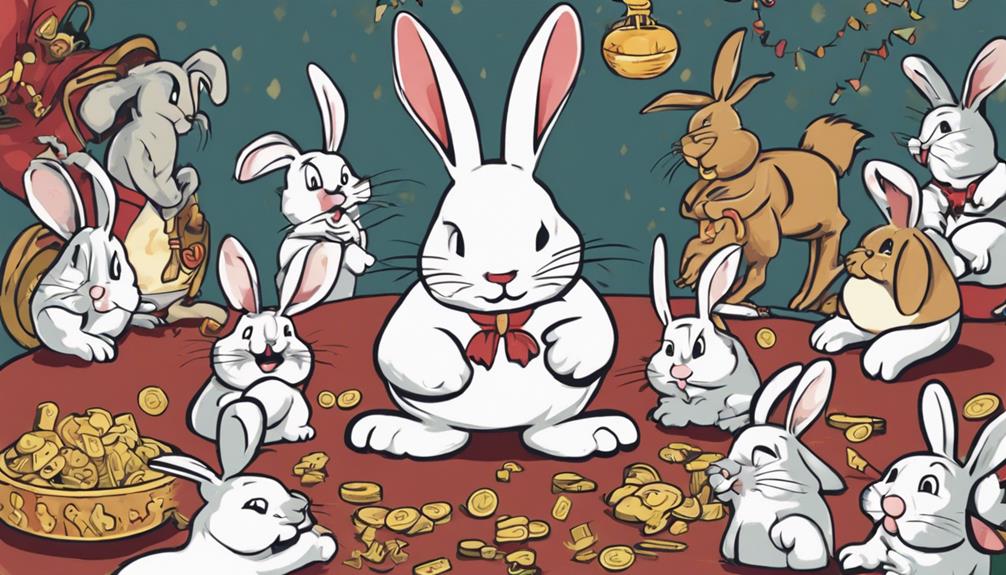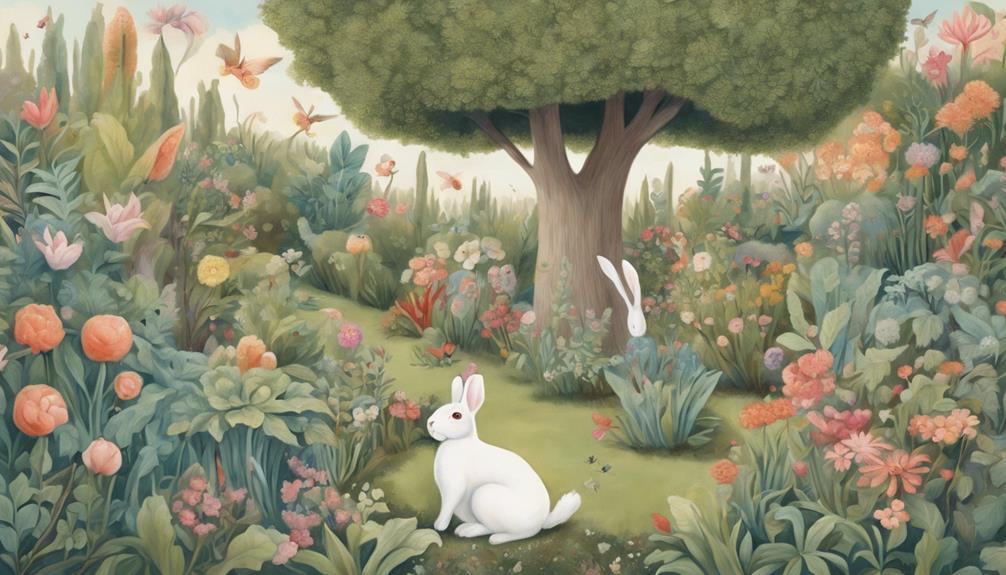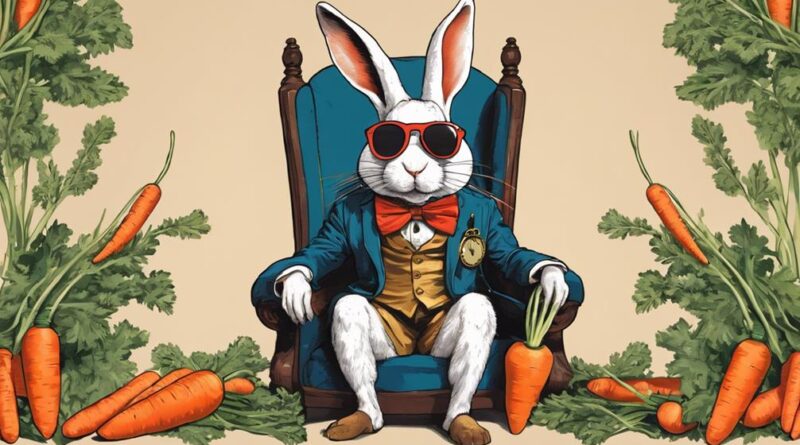Top 10 Popular Rabbit Myths in Pop Culture
Discover popular rabbit myths like the Energizer Bunny not actually drumming and the Playboy Bunny stereotype that oversimplifies their role. The White Rabbit symbolizes punctuality, while the March Hare's tea party scene in 'Alice's Adventures in Wonderland' showcases absurdity. Roger Rabbit blurs lines between animation and reality, captivating audiences. Unravel more captivating rabbit myths in pop culture and explore the intriguing symbolism these characters hold.
Energizer Bunny Drumming Myth
Contrary to popular belief, the Energizer Bunny doesn't actually drum the beat in its commercials. The misconception of the drumming bunny stems from the iconic advertisement campaigns of the Energizer batteries. The Energizer Bunny first appeared in 1989, symbolizing longevity and endurance, but the idea that it was banging a drum was a misinterpretation. In reality, the bunny was depicted with a pair of sunglasses and flip-flops, marching through various scenes to showcase the long-lasting power of Energizer batteries.
The rabbit stereotype debunked in the case of the Energizer Bunny highlights how easily misconceptions can arise in popular culture. The bunny's continued march was a clever way to emphasize the never-ending energy of the batteries it represented. By perpetuating the idea of a drumming bunny, viewers unknowingly added a musical element to the advertisement that was never intended. The Energizer Bunny's true purpose was to embody the concept of 'going and going,' not to play a drum.
Playboy Bunny Stereotype Myth
The Playboy Bunny Stereotype Myth has long been a subject of misunderstanding and misconception surrounding the iconic symbol. When people think of the Playboy Bunny, they often conjure up images of a scantily clad woman in a revealing bunny costume, complete with bunny ears. However, this stereotype oversimplifies the role of the Playboy Bunny and the history behind this iconic figure.
The reality is that the Playboy Bunny costume was designed with specific guidelines to exude elegance and sophistication rather than overt sexuality. The classic Bunny costume featured a corset, a bunny tail, cuffs, a collar with a bow tie, and the iconic bunny ears. The outfit was more about creating a fantasy image of luxury and exclusivity rather than being overtly provocative.
Moreover, the Bunny ears worn by Playboy Bunnies weren't just a playful accessory but also a symbol of empowerment. The ears represented the Bunnies' status as keyholders to the Playboy Club, signifying their role as hostesses and entertainers rather than mere objects of desire.
White Rabbit Timekeeper Myth
One common misconception surrounding the White Rabbit Timekeeper myth involves its origins and significance within rabbit folklore. In various pop culture references, the White Rabbit is often portrayed as a time travel rabbit or a clockwork rabbit, responsible for maintaining order and punctuality in different realms. This myth originates from Lewis Carroll's 'Alice's Adventures in Wonderland,' where the White Rabbit famously exclaims, 'I'm late, I'm late, for a very important date!' This phrase has cemented the White Rabbit as a symbol of time consciousness and the importance of keeping to schedules.
The concept of a timekeeping rabbit has intrigued audiences for generations, leading to its portrayal in movies, books, and art. The White Rabbit's association with time travel stems from its role as Alice's guide through the whimsical Wonderland, where time behaves erratically. The idea of a clockwork rabbit suggests a meticulously organized creature, always on time and precise in its movements.
Despite its fictional origins, the White Rabbit Timekeeper myth has become a symbol of the human obsession with time and punctuality. It serves as a reminder to value time and to be mindful of how it's spent. The White Rabbit continues to capture imaginations, inspiring creativity and prompting contemplation on the nature of time itself.
March Hare Tea Party Myth
With roots in classic literature and whimsical folklore, the March Hare Tea Party Myth holds a prominent place in rabbit-themed narratives. This myth is famously depicted in Lewis Carroll's 'Alice's Adventures in Wonderland,' where the March Hare is a central character in the iconic tea party scene. Alongside the Mad Hatter and the Dormouse, the March Hare engages in nonsensical conversations and peculiar behavior, creating an atmosphere of absurdity and whimsy.
The tea party itself is a chaotic affair, with the Mad Hatter constantly asking riddles and the March Hare offering Alice riddles with no answers. This portrayal of the March Hare as a participant in a never-ending tea party has become a symbol of the unpredictable and eccentric nature of Wonderland.
In 'Alice's Adventures in Wonderland,' the March Hare's behavior at the tea party contrasts with the punctuality and urgency associated with the White Rabbit. While the White Rabbit is always in a hurry and worried about being late, the March Hare seems to exist in a perpetual state of timelessness and frivolity.
Roger Rabbit Real-Life Myth
In popular culture, the Roger Rabbit Real-Life Myth intertwines fantasy and reality, blurring the lines between animation and the tangible world. Roger Rabbit, an iconic character, sparked a cartoon controversy when he first appeared in the 1988 film 'Who Framed Roger Rabbit.' The myth surrounding Roger Rabbit suggests that he exists in real life, able to interact with humans seamlessly. This notion was perpetuated by the groundbreaking technology used in the film, which seamlessly blended live-action with animation.
Despite the remarkable visual effects that brought Roger Rabbit to life on screen, the idea of a real-life Roger Rabbit is purely fictional. The character was created through a combination of skilled animation, voice acting, and clever cinematography. While Roger Rabbit may seem incredibly lifelike, he remains a product of the imagination, existing solely within the realm of entertainment.
This myth has endured over the years, captivating audiences and fueling speculation about the existence of animated characters in the real world. The Roger Rabbit Real-Life Myth serves as a testament to the power of storytelling and the enduring appeal of beloved characters like Roger Rabbit. Though he may not walk among us, his presence in pop culture continues to enchant audiences of all ages.
Trix Rabbit Cereal Addiction Myth
The whimsical world of rabbit myths takes a different turn with the intriguing Trix Rabbit Cereal Addiction Myth, adding a touch of mystery to the realm of animated characters and their peculiar behaviors. This myth revolves around the beloved Trix Rabbit from the popular cereal brand Trix, known for its colorful fruit-flavored puffs. The story goes that the Trix Rabbit developed an insatiable craving for the sugary breakfast cereal, leading to a spiral of addiction and erratic behavior.
The Trix Rabbit Cereal Addiction Myth highlights the dangers of sugar overload and the consequences of indulging in unhealthy eating habits. In this myth, the Rabbit intervention takes the form of children who consistently thwart the Trix Rabbit's attempts to enjoy a bowl of Trix cereal, believing it's only meant for them. This intervention serves as a cautionary tale against excessive consumption of sugary treats and the importance of moderation in diet.
As the myth unfolds, the Trix Rabbit is often depicted scheming ways to get his paws on the coveted Trix cereal, only to be foiled time and again. The narrative subtly touches on themes of self-control, addiction, and the need for Rabbit rehab to break free from unhealthy dependencies. The Trix Rabbit Cereal Addiction Myth ultimately serves as a whimsical yet insightful story that resonates with audiences of all ages.
Thumper Rabbit Foot Stigma Myth

Despite its popularity, the Thumper Rabbit Foot Stigma Myth continues to perpetuate misconceptions about rabbits and their supposed lucky charms. The belief that carrying a rabbit's foot brings good luck has been deeply ingrained in various cultures for centuries. However, it's essential to debunk this myth and understand the reality behind it.
Rabbits are often associated with luck due to their reproductive prowess, agility, and ability to evade predators. This positive image has led to the misconception that carrying a rabbit's foot can bring good fortune. The origin of this myth can be traced back to ancient Celtic tribes who believed in the rabbit's supernatural abilities to ward off evil spirits. Over time, this belief evolved, and the rabbit's foot became a talisman for luck in various societies.
In reality, the idea of a rabbit's foot as a lucky charm is based more on superstition than fact. The practice of carrying a rabbit's foot for luck has led to the unfortunate stigma of harming these animals for their appendages. It's crucial to understand that rabbits are gentle creatures that shouldn't be harmed or exploited for superstitious beliefs. Instead of perpetuating this myth, it's important to appreciate rabbits for their natural beauty and grace, rather than reducing them to mere symbols of good luck.
Oswald Lucky Rabbit Origin Myth
The mysterious origins of the Oswald Lucky Rabbit myth have intrigued enthusiasts and historians alike. Oswald, the precursor to Mickey Mouse, was created by Walt Disney and Ub Iwerks in 1927. The character gained immense popularity in silent cartoons during the late 1920s. Oswald, known for his mischievous yet endearing personality, quickly became a beloved figure in early animation history.
Despite Oswald's success, a contractual dispute led to Disney losing the rights to the character in 1928. This loss prompted Disney to create a new character, Mickey Mouse, who'd go on to achieve even greater fame. The story of Oswald's origins and the subsequent loss of the character to Universal Studios is a cautionary tale in the world of entertainment.
The Lucky Rabbit, as Oswald was often called, holds a special place in the hearts of animation aficionados. The truth behind Oswald's creation and subsequent departure from Disney's hands serves as a reminder of the complexities of intellectual property rights in the entertainment industry. While Oswald may not be as widely recognized as Mickey Mouse today, his legacy as the Lucky Rabbit lives on as a testament to the ever-evolving nature of animation history.
Harvey Pooka Invisible Rabbit Myth

Harvey Pooka, the invisible rabbit myth, captivates audiences with its whimsical tale of an unseen companion. This story delves into the concept of an invisible friend, portraying Harvey as the loyal and endearing companion of Elwood P. Dowd. The notion of an invisible creature may seem fantastical, but it serves as a metaphor for companionship, acceptance, and the beauty of imagination.
Harvey is often portrayed as a misunderstood creature, with many characters in the narrative questioning his existence. However, the essence of Harvey lies beyond mere visibility; he symbolizes the intangible qualities of friendship and loyalty. Through Harvey, the myth challenges individuals to look beyond the surface and embrace the idea that companionship can come in various forms.
The invisible rabbit myth of Harvey Pooka has endured in pop culture due to its ability to evoke emotions and provoke thought. It prompts viewers to contemplate the nature of relationships and the significance of belief in the unseen. The story of Elwood and his invisible companion resonates with audiences because it taps into universal themes of connection and understanding.
Bugs Bunny Notorious Trickster Myth
In the realm of rabbit folklore, Bugs Bunny stands out as a notorious trickster, known for his cunning and mischievous antics. Created by Warner Bros. in the late 1930s, Bugs Bunny quickly became an iconic character in American pop culture, embodying the clever and quick-witted nature often associated with rabbits. Bugs Bunny's mischievous behavior is exemplified in his interactions with other characters, particularly his penchant for outsmarting foes like Elmer Fudd and Yosemite Sam.
One of Bugs Bunny's most famous tricks is his ability to manipulate situations to his advantage through clever wordplay and physical comedy. His catchphrase, 'What's up, Doc?' delivered with a nonchalant grin, has become synonymous with his playful and sometimes sly demeanor. Bugs Bunny's mischievous antics often involve elaborate pranks and schemes, showcasing his resourcefulness and intelligence.
Despite his trickster persona, Bugs Bunny is also known for his sense of justice and fairness. While he may play tricks on his adversaries, Bugs Bunny typically reserves his antics for those who deserve it, standing up for the underdog and using his cunning to right wrongs. This complex character has endeared Bugs Bunny to audiences of all ages, solidifying his place as one of the most beloved and enduring figures in the world of animation.
Frequently Asked Questions
Are Rabbits Really Lucky Like the March Hare?
Rabbits are often associated with luck due to the myth of the March Hare. In reality, rabbit superstitions have varied meanings across cultures.
While some view rabbits as lucky symbols, others see them as tricksters or symbols of fertility. The idea of rabbits being consistently lucky is debunked when considering the diverse rabbit symbolism explained in different traditions.
Do All Rabbits Have a Cereal Addiction Like Trix Rabbit?
Well, when it comes to bunny behavior, not all rabbits have a cereal addiction like the Trix rabbit.
This stereotype in popular culture may make it seem like all rabbits are obsessed with sugary cereals, but in reality, rabbits have very specific dietary needs.
Feeding them sugary treats can actually be harmful to their health. It's essential to provide rabbits with a balanced diet of hay, fresh vegetables, and a small amount of pellets.
Is Having a Rabbit's Foot Really Considered Lucky?
Having a rabbit's foot isn't actually considered lucky in reality. This superstition stems from a belief that rabbit's feet bring good fortune, but it's just a myth.
Rabbit symbolism plays a role in various cultures, but it's more about the animal's characteristics like agility and fertility.
In some places, rabbit hopping is a sport, not just a superstition.
How Did Harvey Pooka Become an Invisible Rabbit?
To become an invisible rabbit, Harvey Pooka's origin story intertwines with the idea of invisible companions and magical creatures. In the tale, Harvey isn't merely a product of psychological delusions or imaginary friends, but a manifestation of a deeper connection to the unseen world.
This transformation into an invisible rabbit symbolizes the power of belief, the blurred lines between reality and fantasy, and the enchanting allure of mystical beings in storytelling.
Is Bugs Bunny Always Outsmarting Everyone in Cartoons?
Bugs Bunny, the iconic cartoon character, is known for his intelligence and comedic value in outsmarting others. This portrayal of rabbit intelligence has solidified stereotypes in cartoons where rabbits are often depicted as clever and cunning.
Bugs Bunny's impact goes beyond entertainment, shaping how we perceive rabbits in pop culture. His antics showcase a balance of wit and humor, contributing to the enduring popularity of this beloved character.
Conclusion
In conclusion, these popular rabbit myths in pop culture have been perpetuated through various forms of media and entertainment. Despite their widespread presence, it's important to recognize the misconceptions and stereotypes that they may perpetuate.
By debunking these myths and gaining a better understanding of rabbits and their behaviors, we can appreciate these unique creatures in a more accurate and respectful light.
It's always important to question and challenge the narratives that shape our perceptions of animals in popular culture.
